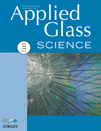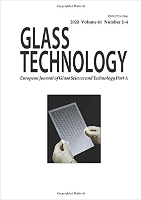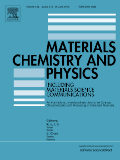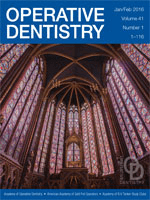
GLASS PHYSICS AND CHEMISTRY
Scope & Guideline
Bridging theory and application in glass research.
Introduction
Aims and Scopes
- Synthesis and Characterization of Glass Materials:
The journal covers the synthesis techniques of various glass compositions, including traditional methods and modern techniques like sol-gel and microwave synthesis. It emphasizes the characterization of these materials using advanced spectroscopic and structural analysis methods. - Optical and Photonic Properties:
A significant focus is placed on the optical properties of glasses, including their luminescent behavior, refractive indices, and applications in photonics and laser technologies. - Thermal and Mechanical Properties:
Research articles often investigate the thermal stability, expansion, and mechanical properties of glass materials, contributing to the understanding of their performance in practical applications. - Environmental and Functional Applications:
The journal also explores the use of glass materials in environmental applications, such as waste management and photocatalysis, as well as functional applications in electronics and energy sectors. - Intermetallic and Hybrid Systems:
There is a unique emphasis on the study of intermetallic systems and hybrid materials, particularly those involving glassy matrices, which can lead to novel materials with tailored properties.
Trending and Emerging
- Nanocomposite and Hybrid Materials:
There is a growing trend towards the study and development of nanocomposite and hybrid materials, where glass matrices are integrated with nanoparticles to enhance properties and functionalities, particularly in photonics and catalysis. - Sustainability and Recycling in Glass Production:
Research focusing on sustainable practices in glass manufacturing, including recycling techniques and the use of waste materials as raw components, is increasingly prevalent, reflecting a broader environmental consciousness. - Advanced Spectroscopic Techniques:
The use of advanced spectroscopic techniques, such as Raman spectroscopy and X-ray photoelectron spectroscopy, is on the rise, allowing for more detailed analysis of glass structures and properties. - Smart and Functional Glasses:
The development of smart glasses with functionalities such as self-cleaning, superhydrophobicity, and response to environmental stimuli is an emerging area of interest, indicating a shift towards multifunctional materials. - Interdisciplinary Applications:
There is a noticeable increase in research that intersects with other fields, such as biology and medicine, where glass materials are being explored for applications in biocompatibility and drug delivery systems.
Declining or Waning
- Traditional Glass Formulations:
Research focusing solely on traditional glass compositions, such as soda-lime and borosilicate glasses, appears to be declining. The journal is shifting towards more innovative materials and formulations that address modern technological needs. - Basic Glass Chemistry Studies:
There seems to be a waning interest in fundamental studies of glass chemistry without application context. More emphasis is now placed on applied research that connects glass chemistry to practical outcomes. - Classical Thermal Analysis Techniques:
Classical thermal analysis methods, such as differential thermal analysis (DTA) and thermogravimetric analysis (TGA), are being supplemented or replaced by more advanced techniques that provide deeper insights into glass behavior under various conditions.
Similar Journals

Korean Journal of Materials Research
Advancing the Frontiers of Materials ScienceKorean Journal of Materials Research is a pivotal publication in the field of materials science, offering a platform for innovative research and comprehensive reviews in miscellaneous materials applications. Published by the MATERIALS RESEARCH SOC KOREA, this journal has been a valuable resource since its inception in 2007 and continues to disseminate vital findings through 2024. Although currently categorized in Q4 of the Materials Science quartiles, the journal is committed to advancing knowledge and fostering research collaboration within the scientific community. With an ISSN of 1225-0562 and an E-ISSN of 2287-7258, the journal aims to bridge gaps in research and practice, appealing to a diverse audience of researchers, professionals, and students interested in the latest advancements in materials science. While access to content may not be open, the journal's impact in the regional and global research landscape is steadily growing, as indicated by its Scopus ranking in the 7th percentile of General Materials Science. Engage with the Korean Journal of Materials Research to stay at the forefront of materials innovation!

Crystals
Bridging Theory and Application in Materials ScienceCrystals is a premier open-access journal, published by MDPI since 2011, that focuses on the multidisciplinary fields of chemical engineering, condensed matter physics, inorganic chemistry, and materials science. With its E-ISSN 2073-4352, the journal is headquartered in Switzerland, and actively contributes to the global scientific community by facilitating the dissemination of high-quality research. Ranking in the Q2 quartile across multiple categories, including Chemical Engineering (miscellaneous) and Materials Science (miscellaneous) for 2023, Crystals provides a platform for innovative studies that span from fundamental research to practical applications. The journal's commitment to open access ensures that groundbreaking findings are readily available to researchers, professionals, and students alike, fostering an environment of collaboration and knowledge sharing that is essential in advancing the scientific understanding of crystalline materials.

Materials Letters-X
Fostering Innovation in Condensed Matter PhysicsMaterials Letters-X, published by ELSEVIER, is an esteemed open-access journal dedicated to the rapid communication of research in the fields of Condensed Matter Physics, Materials Science, Mechanical Engineering, and Mechanics of Materials. Launched in 2019, this journal has quickly established itself within the academic community, achieving Q3 quartile rankings in several categories according to the 2023 metrics. The journal's impactful contributions are reflected in its Scopus rankings, notably within Mechanical Engineering (Rank #308) and Mechanics of Materials (Rank #199). The open-access model promotes widespread dissemination and accessibility, ensuring that cutting-edge advancements in material science are readily available to researchers, professionals, and students worldwide. As it continues to grow, Materials Letters-X aims to inspire innovation and collaboration across disciplines, making it a pivotal resource for those engaged in material research and applications.

International Journal of Applied Glass Science
Advancing Innovations in Glass ScienceThe International Journal of Applied Glass Science, published by Wiley Periodicals, Inc, is a leading scholarly journal in the field of materials science, particularly focusing on the applications and innovations in glass science. Since its inception in 2010, the journal has served as a vital platform for disseminating high-quality research and advancing knowledge within the community, maintaining a respectable Q2 ranking in the Materials Science (Miscellaneous) category as of 2023. With an ISSN of 2041-1286 and E-ISSN of 2041-1294, it continues to attract a diverse array of manuscripts that explore fundamental and applied aspects of glass technology and its countless applications. Scholars and professionals benefit from the journal’s commitment to transparency and accessibility, even in the absence of an open access model, thereby reinforcing its relevance in an evolving academic landscape. The journal is positioned to be an influential resource for researchers, professionals, and students keen to stay at the forefront of glass science developments.

Materials Science-Medziagotyra
Connecting Scientists, Students, and Industry LeadersMaterials Science-Medziagotyra is a prominent peer-reviewed journal dedicated to the field of materials science, published by Kaunas University of Technology in Lithuania. Since its transition to an Open Access model in 2012, it has facilitated broad dissemination of research findings, enhancing accessibility for researchers and professionals worldwide. This journal is indexed in Scopus and has consistently contributed to the academic community with a focus on innovative materials and their applications, ranking in the Q3 category of Materials Science (miscellaneous) as of 2023. With the responsibility of synthesizing substantial research from 2008 through 2024, Materials Science-Medziagotyra aims to bridge gaps in material research while fostering collaboration among scientists, students, and industry leaders. Its commitment to quality and rigor in scientific discourse underscores its relevance and importance in advancing the field.

Glass Technology-European Journal of Glass Science and Technology Part A
Shaping the Glass Industry with Cutting-Edge DiscoveriesGlass Technology - European Journal of Glass Science and Technology Part A, published by the SOC GLASS TECHNOLOGY in the United Kingdom, is an esteemed journal dedicated to advancing the field of glass science and technology. With a focus on ceramics, composites, and materials chemistry, the journal plays a pivotal role in disseminating significant research findings and innovations in glass technology. Despite its current positioning in the lower quartiles (Q4) of the 2023 category rankings, this journal serves as a valuable platform for emerging research and novel technologies within its domain. Researchers, professionals, and students are encouraged to explore the journal's contributions from 2006 through to 2024, which include peer-reviewed articles, reviews, and case studies essential for anyone involved in the glass industry or related fields. Though it operates under a subscription model, it maintains rigorous academic standards, ensuring that each publication meets the highest criteria for quality and relevance.

MATERIALS CHEMISTRY AND PHYSICS
Pioneering Discoveries in Condensed Matter PhysicsMATERIALS CHEMISTRY AND PHYSICS is a leading peer-reviewed journal published by Elsevier Science SA, focusing on the intersection of materials science and condensed matter physics. With an esteemed impact factor and a distinguished reputation in its field, this journal holds a Q1 ranking in Condensed Matter Physics and a Q2 ranking in miscellaneous Materials Science categories as of 2023. Spanning over three decades since its inception in 1983, it provides a vital platform for researchers, professionals, and students to disseminate cutting-edge findings and innovations in materials characterization, properties, and applications. The journal is indexed in Scopus, boasting impressive rankings that reflect its commitment to publishing high-quality research. Although it does not currently offer an Open Access option, it remains an essential resource for those seeking to stay at the forefront of materials chemistry and physics.

OPERATIVE DENTISTRY
Fostering Excellence in Dental Care through Scholarly ContributionsOPERATIVE DENTISTRY is a premier academic journal dedicated to the advancement of knowledge in the field of dentistry, particularly focusing on operative techniques, materials, and innovations. Published by OPERATIVE DENTISTRY INC, this journal holds an esteemed reputation as indicated by its classification within the Q1 quartile in Dentistry and Q2 in Medicine for 2023, and it ranks #40 out of 132 in the general dentistry category, placing it in the 70th percentile according to Scopus. With a commitment to high-quality research since its inception in 1976, the journal serves as an essential resource for researchers, practitioners, and students alike, fostering the dissemination of cutting-edge findings and developments in operative dentistry. The journal does not have an open access option; however, it provides access to a wealth of information crucial for the enhancement of clinical practice and patient care. With its headquarters located at Indiana University School of Dentistry in Indianapolis, IN, OPERATIVE DENTISTRY remains at the forefront of dental research and education.

Ceramics International
Championing excellence in ceramic materials research.Ceramics International is a premier journal published by ELSEVIER SCI LTD, focusing on advancing the field of materials science with a specific emphasis on ceramics and composites. With an impressive impact factor and a top-tier standing in several critical categories, including Q1 rankings in Ceramics and Composites, Electronic, Optical and Magnetic Materials, and Materials Chemistry, this journal serves as a crucial resource for researchers and professionals alike. Established in 1981, it has consistently showcased cutting-edge research in various domains, including surfaces, coatings, and process chemistry technologies, making it invaluable for those advancing theoretical and practical knowledge in these areas. While access is through subscription, the journal’s rich content, profound insights, and rigorous peer-review process ensure high-quality articles that contribute meaningfully to the scientific community. By fostering innovation and collaboration through rigorous research, Ceramics International stands out as an authoritative source for those dedicated to the evolution of materials science.

INTERMETALLICS
Unveiling the Secrets of Metals and AlloysINTERMETALLICS, a prestigious journal published by ELSEVIER SCI LTD in the United Kingdom, has been a vital resource in the fields of Materials Science, Mechanical Engineering, and Chemistry since its inception in 1993. Renowned for its rigorous peer-review process and commitment to high-quality research, this journal enjoys an impressive position within the top quartile (Q1) rankings of its categories, signifying its influence and esteem in the academic community. With a particular emphasis on the study of intermetallic compounds and their applications, INTERMETALLICS attracts groundbreaking research and innovative contributions that push the boundaries of knowledge in metals and alloys, as well as mechanics of materials. Researchers looking for a platform to disseminate cutting-edge findings will find this journal an exemplary choice, further enhanced by its commendable Scopus rankings that illustrate its widespread recognition and relevance. Though it does not currently offer Open Access options, the journal remains committed to advancing the field through selective publication of impactful research, making it an essential reference for researchers, professionals, and students alike interested in the dynamic interplay between materials and engineering.